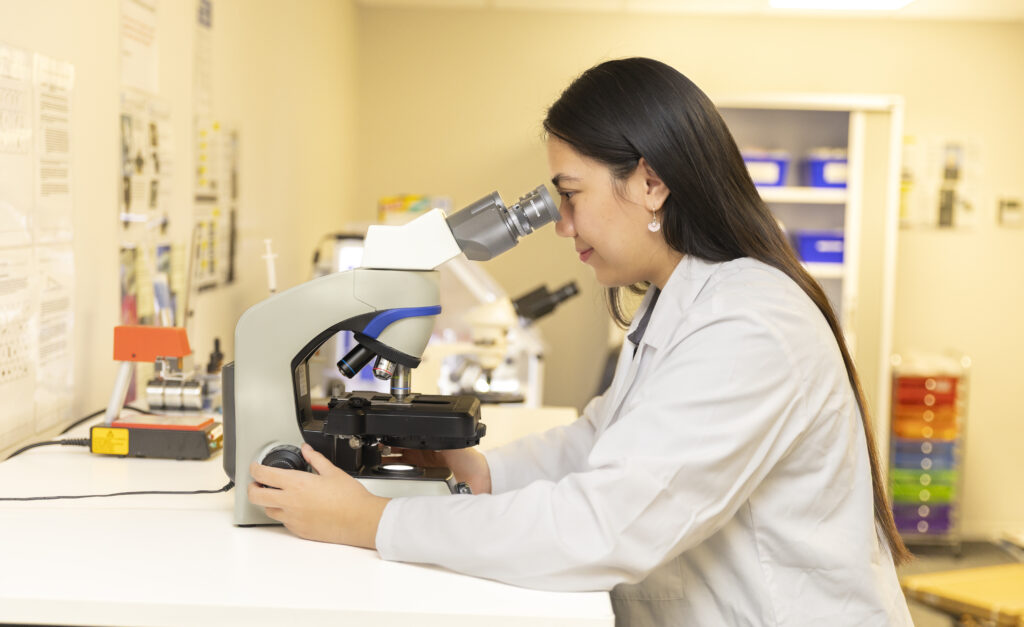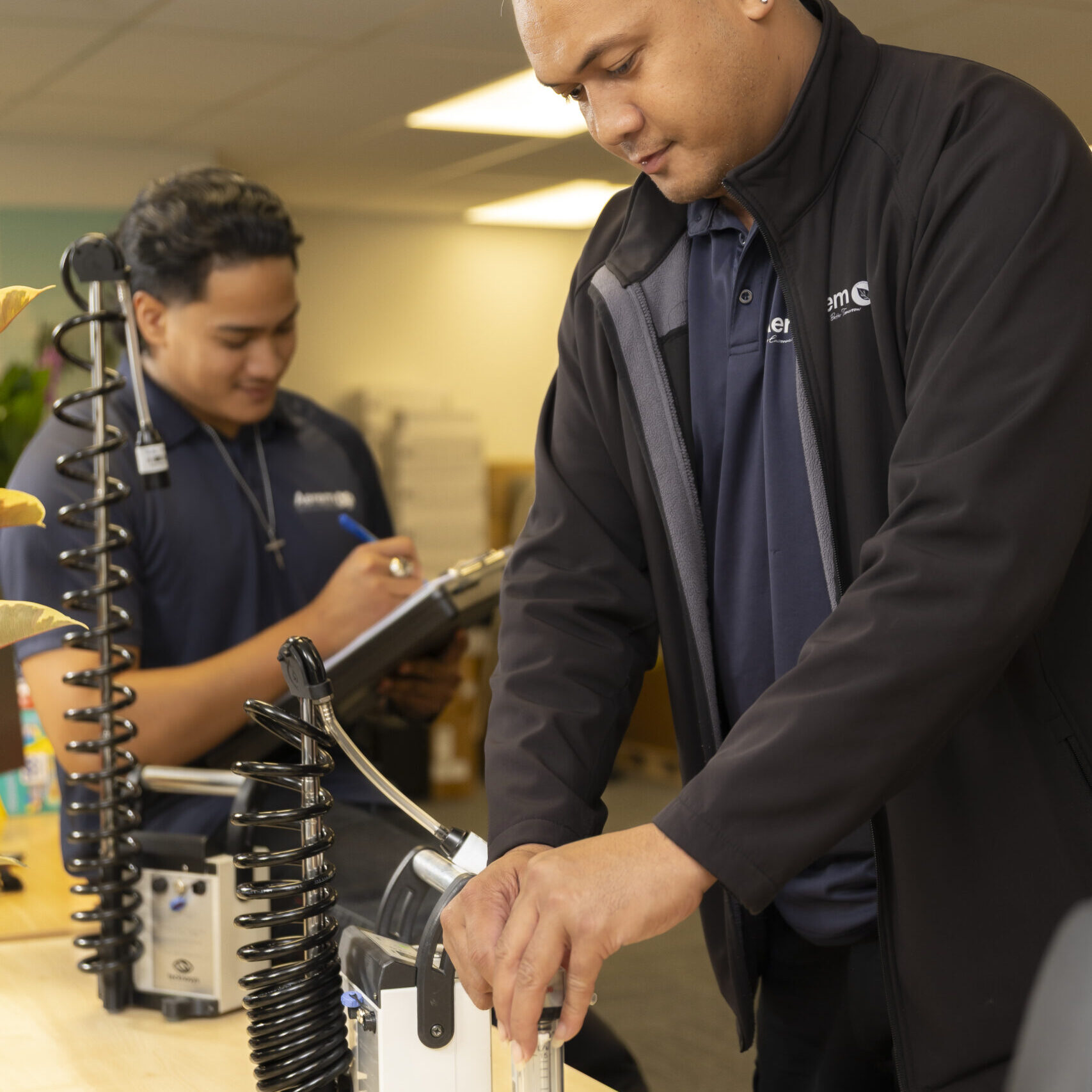Fibre Counting Analysis
Asbestos fibre counting is a Phase Contrast microscopic analysis of air samples to determine the concentration of airborne asbestos fibres. This process is crucial for:
Verifying the effectiveness of asbestos removal or encapsulation
Confirming safe reoccupation of areas post-remediation
Monitoring occupational exposure levels
Supporting WorkSafe clearance requirements

- About The Service
Why Is Fibre Counting Essential?
When asbestos-containing materials are disturbed — whether during removal, maintenance, or an unexpected event — they release microscopic fibres into the air. These fibres are invisible, inhalable, and hazardous.
Fibre counting is essential for:
- Health and Safety Confirms whether airborne asbestos fibre levels are below occupational exposure limits.
- Final Clearance & Re-occupancy Mandatory after Class A removal to ensure a site is safe to re-enter
- Incident Response Assesses contamination after unplanned disturbances or emergency events.
- Assessment of the final asbestos removal plan: verifying completeness and feasibilityAlthough we do not manage removal works directly, our independent advice and market expertise ensure you receive the safest and most cost-effective solution for your asbestos challenges.

Navigating Asbestos Compliance with Expertise
Asbestos is a naturally occurring mineral fibre once widely used in products like:
- Insulation and fireproofing materials
- Vehicle braking systems
- Construction materials such as wallboards
- Asbestos cement products such as roofing or cladding
Airborne asbestos fibres can become deeply embedded in lung tissue, leading to serious and irreversible health conditions over time. That’s why accurate identification, monitoring, and control of airborne fibres is essential—especially in environments where asbestos-containing materials may be disturbed, degraded, or removed.
At the core of this process is fibre counting—a critical analytical method that measures the concentration of asbestos fibres in the air. It provides the evidence needed to verify safety, protect workers and occupants, and support regulatory clearance decisions following asbestos-related work.
Regulatory Requirements You Must Meet
At Aerem, we deliver tailored, end-to-end asbestos management solutions — covering everything from asbestos surveying and risk assessment to air monitoring and fibre counting.
Under the Health and Safety at Work (Asbestos) Regulations 2016, all workplaces with identified or presumed asbestos — including contaminated soils — must have a current and effective Asbestos Management Plan (AMP) in place.
We don’t just tick boxes — our goal is to ensure your property exceeds minimum compliance by setting a benchmark for safety, accountability, and operational excellence.
With PTA-participating and BOHS P403-qualified analysts, we perform ISO 8672:2014-compliant fibre counting to verify air quality during and after asbestos works — giving you clear, defensible results and the confidence to move forward safely.

- Pricing
Transparent Pricing & Tailored Solutions
All assessments are customised based on your specific needs. We’ll provide a clear quote before beginning any work, ensuring you know exactly what to expect.
Fibre Counting Analysis
Self-sampling
Price per sample
$75 + GST
We take your samples
Price per sample
$65 + GST
*For destinations over 20km
$450 + GST
*Includes 1 free sample
- How It Works
Our Process
1.
Site Assessment & Monitoring Setup
We begin by assessing the scope and location of works, then strategically place personal or static air sampling pumps to capture representative airborne fibre levels.
- Placement based on risk and regulatory requirements
- Calibration of pumps to exact flow rates
- Filter media (0.8 μm pore size) installed under controlled conditions
2.
Air Sample Collection
Using low-volume air sampling pumps, air is drawn through cellulose ester membrane filters over a defined period (typically 4 hours or as specified for clearance/exposure testing).
- Real-time flow checks ensure sample integrity
- Volume and duration recorded accurately
- Each sample is uniquely labelled and tracked
3.
Laboratory Analysis (PCM)
Samples are prepared in our controlled lab by BOHS P403-qualified analysts. The filters are chemically cleared, mounted onto slides, and analysed using Phase Contrast Microscopy (PCM) in line with ISO 8672:2014. (Membrane Filter Mehod)
- PTA-participating lab processes
- Only fibres meeting regulatory size criteria are counted
- Results expressed in fibres per millilitre (f/mL)
- Blank filter controls
- Cross-checked counts by independent analysts
- Ongoing participation in Proficiency Testing Australia (PTA) schemes
4.
Reporting & Interpretation
A clear, concise report is delivered to you — typically within 24 hours (or same-day if required). Reports include:
- Fibre concentration results
- Compliance statements
- Recommendations for clearance or further action
- Supporting photos, sample details, and chain of custody (COC)
FAQs
What is asbestos air monitoring?
Air monitoring involves collecting air samples during or after asbestos-related work to measure airborne fibre levels. It’s used for:
Clearance testing
Background monitoring
Exposure assessments
Reassurance monitoring
Emergency response
What is fibre counting?
Fibre counting is a laboratory technique used to measure the concentration of airborne asbestos fibres. It helps determine whether an area is safe to occupy after asbestos removal or disturbance and ensures compliance with WorkSafe NZ regulations.
Why is fibre counting important?
Airborne asbestos fibres cannot be seen by the naked eye. Inhalation can cause serious, often fatal diseases such as:
Mesothelioma
Lung cancer
Asbestosis
Fibre counting provides a quantifiable measure of airborne asbestos and verifies whether controls are effective and regulatory clearance criteria are met.
Fibre counting is a laboratory technique used to measure the concentration of airborne asbestos fibres. It helps determine whether an area is safe to occupy after asbestos removal or disturbance and ensures compliance with WorkSafe NZ regulations.
How are asbestos fibres counted?
In New Zealand, fibre counting is usually performed using Phase Contrast Microscopy (PCM) in accordance with the Membrane Filter Method (WorkSafe NZ / AS 3640 standard). A measured volume of air is drawn through a filter, which is then prepared and examined under the microscope by a trained analyst.
What is the clearance level for asbestos?
The clearance level in New Zealand is <0.01 fibres per millilitre of air (f/mL), determined by PCM. If the fibre concentration is at or above this level, further cleaning and re-monitoring is required before the area can be declared safe.
Who can perform asbestos fibre counting?
Fibre counting must be carried out by a competent analyst in an IANZ-accredited laboratory, using recognised methods and calibrated equipment.
When is fibre counting required?
During Class A asbestos removal to check controls (control monitoring)
After removal work as part of the Four Stage Clearance Process
For personal monitoring to measure individual worker exposure
In perimeter monitoring to protect nearby occupants or the public
Does fibre counting identify asbestos types?
No. Fibre counting by PCM measures total respirable fibre concentrations, not the fibre type. To confirm whether fibres are asbestos (and identify the type), further analysis using polarised light microscopy (PLM) or transmission electron microscopy (TEM) is required.
How can Aerem help?
Aerem Environmental provides:
On-site air sampling during asbestos works
Accurate fibre counting by IANZ-accredited analysts
Clearance monitoring in line with the Four Stage Clearance procedure
Compliance reports to meet WorkSafe NZ requirements
Get in touch with us
Not sure which service to choose? Get on a call to find your best fit.
